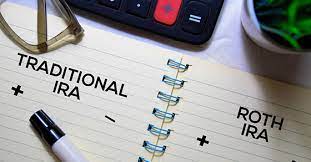What are the advantages of a Roth IRA versus a Traditional IRA? In this article we will go through the basics of a Roth IRA versus a Traditional IRA and what you need to know about the differences between the two. I hope this will give you the insight you need to make the right decision on what is the best option for you. Keep reading to find out!

A traditional IRA is an individual retirement account through which you can make contributions from your pre-tax income. This means the deposits to a traditional IRA are made before your earnings are deducted from any taxes instead of a Roth IRA account. This allows the investment to grow tax differed. However, tax is paid on withdrawals based on the current income tax when you retire. An IRA broker or a bank can open a traditional IRA account. With a broker, you are provided with the option of investing in bonds and stock.
On the other hand, the banks avail certificates of deposits and savings accounts. In the traditional IRA, the growth of your investment depends on how well you invest, and if you are going to lose money on the assets you have chosen. In this option, it’s advisable to invest in stocks and bonds because they are known to yield higher returns.
Traditional IRA Contribution
A traditional IRA has contribution limits of $6,000 annually and $7,000 for individuals above 50 years. Another basic rule of this IRA account is that you can only invest if you have earned income. However, you can also increase your investment into this account by rolling over from another retirement account.
For example, you can roll over your 401(k) plan to your IRA account. As I have mentioned, the account is tax-free until you withdraw your funds. Early withdrawals are also taxed as income but may attract a 10% penalty.
Traditional IRA Distribution
In a traditional IRA, you start taking distributions once you reach the age of 59.5 years. Taking money out of the account is what warrants the 10% tax penalty.
However, there are options through which you can do this without penalties. For example, you can spend up to $10,000 from your IRA account on the purchase of your first house; though you won’t pay penalties, you will owe tax on the distribution. This also applies to paying college expenses from a traditional IRA account.
Roth IRA
A Roth IRA is also an individual retirement account; the difference with the traditional IRA is that deductions are made after your earnings income tax has been paid. This means the money deposited into this account is not tax-deductible; hence, your investment grows tax differed.
You should also note that Roth account withdrawals are not liable for taxes as in a traditional IRA account. However, the account needs to have been active for five years. You also need to have reached the age of 59.5 when making the withdrawals.
Roth IRA Contributions

The contributions limits to A Roth IRA are similar to the traditional IRA account. The limits are $6,000 per year if you are younger than 50 years and $7,000 if you are past that age. With this account, there is a requirement for eligibility. You need to have made a Modified Adjusted Gross Income (MAGI) amounting to $140,000 if you are servicing the account alone.
For those married and choosing to fill jointly, the amount is $208,000. To open a Roth IRA account, you need to visit a bank or a broker with documents, including proof of income as well as identification. The contributions made into a Roth IRA are made in cash. The account does not allow contributions in the form of bonds, stocks, or any other assets.
The contributions also need to be made from income earned. This means the deposits have to have come from earnings you gained as a result of employment. This means profits made from options such as the sale of stock are not eligible for deposit into a Roth IRA account. Though the funds contributed to your Roth IRA are not taxable, the earnings made from trading of assets within the plan are eligible for taxation at a later time.
Roth IRA Distribution
Roth IRA funds don’t have limitations on withdrawals. Once you reach the age of 59.5 years, you can withdraw at any time without having to pay any additional taxes. The Roth IRA allows you to roll over funds from other IRA plans tax-free. This is also the case if you choose to pass your Roth IRA account funds to a beneficiary.
Traditional IRA
A traditional IRA is an individual retirement account through which you can make contributions from your pre-tax income. This means the deposits to a traditional IRA are made before your earnings are deducted from any taxes instead of a Roth IRA account. This allows the investment to grow tax differed. However, tax is paid on withdrawals based on the current income tax when you retire. An IRA broker or a bank can open a traditional IRA account. With a broker, you are provided with the option of investing in bonds and stock.
On the other hand, the banks avail certificates of deposits and savings accounts. In the traditional IRA, the growth of your investment depends on how well you invest, and if you are going to lose money on the assets you have chosen. In this option, it’s advisable to invest in stocks and bonds because they are known to yield higher returns.
Traditional IRA Contribution

A traditional IRA has contribution limits of $6,000 annually and $7,000 for individuals above 50 years. Another basic rule of this IRA account is that you can only invest if you have earned income. However, you can also increase your investment into this account by rolling over from another retirement account.
For example, you can roll over your 401(k) plan to your IRA account. As I have mentioned, the account is tax-free until you withdraw your funds. Early withdrawals are also taxed as income but may attract a 10% penalty.
Traditional IRA Distribution
In a traditional IRA, you start taking distributions once you reach the age of 59.5 years. Taking money out of the account is what warrants the 10% tax penalty.
However, there are options through which you can do this without penalties. For example, you can spend up to $10,000 from your IRA account on the purchase of your first house; though you won’t pay penalties, you will owe tax on the distribution. This also applies to paying college expenses from a traditional IRA account.
The Differences

Though the traditional IRA and Roth IRA are similar in various aspects, there are differences to note. The traditional IRA allows you to begin taking out distributions from the age of 72 years with a required minimum distribution limit. The Roth IRA, on the other hand, does not have a minimum distribution limit.
The Roth IRA account has income restrictions, and contributions are made after deducting your income tax; thus, the withdrawal will not be liable for taxation. On the other hand, a traditional IRA has no income restriction, and the contributions are made with your pre-tax income. This makes the withdrawals in this account eligible for taxation.
I hope this article was helpful and that you found it interesting. If you have any questions, we will be more than happy to answer them below.
All the best,
Pete
